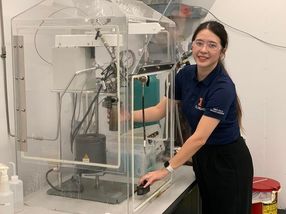How the principle of cheese noodles helps against Alzheimer's
Advertisement
Researchers at the Paul Scherrer Institute PSI have clarified how so-called spermine - a small molecule that regulates many processes in the body's cells - prevents diseases such as Alzheimer's and Parkinson's: it renders certain proteins harmless by acting in a similar way to cheese, which sticks pasta together. This finding could help to combat such diseases. The results have now been published in the journal Nature Communications.
Our life expectancy is increasing - and as a result, age-related illnesses are becoming more common, including neurodegenerative diseases such as Alzheimer's and Parkinson's disease. These diseases in the brain are caused by deposits of harmful protein structures consisting of misfolded so-called amyloid proteins. These resemble fibers or spaghetti in shape. As yet, there is no effective therapy to prevent or get rid of such deposits.
However, an endogenous molecule called spermine raises hope. As researchers led by study leader Jinghui Luo from the Center for Life Sciences at the Paul Scherrer Institute PSI have discovered in experiments, this substance is able to prolong the life of small nematodes, improve their movement in old age and strengthen the power plants of the cells - the mitochondria. In particular, the researchers have observed how spermine helps the body's own defenses to dispose of the nerve-damaging deposits of amyloid proteins.
The new findings could serve as a basis for developing new therapies against such diseases.
A central mediator for cell processes
Spermine is a vital substance for the organism. It belongs to the so-called polyamines, which are relatively small organic molecules. Spermine is named after the seminal fluid sperm, as it is found in particularly high concentrations in sperm and was first discovered over 150 years ago. However, it is also found in many cells in the body - especially those that are active and capable of dividing.
Spermine promotes cell mobility and activity and controls many different processes. Above all, it interacts with the nucleic acids of the genetic material and thus regulates the selection of genes and their conversion into proteins. In this way, it ensures that cells can grow, divide and ultimately die correctly. Spermine is also of central importance for an important cellular process called "biomolecular condensation": certain macromolecules such as proteins and nucleic acids segregate and collect into droplets within the cell, so to speak, so that important reactions can take place there.
In connection with neurodegenerative diseases such as Alzheimer's or Parkinson's, there have already been indications that spermine can protect nerve cells and alleviate age-related memory loss. However, a more precise understanding of how it intervenes in nerve-damaging processes in order to possibly derive medical benefits from this has been lacking until now.
Support for cellular waste disposal
Jinghui Luo's group has now investigated this in more detail. In addition to light microscopy, the researchers also used the SAXS scattering measurement method at PSI's own Swiss Light Source SLS to shed light on the molecular dynamics of the processes. The investigations were carried out both in a glass capillary (in vitro) and in living organisms (in vivo). The nematode C. elegans served as a model organism.
As it turned out, spermine ensures that the harmful proteins collect via biomolecular condensation and clump together to a certain extent. This facilitates a process called autophagy, which routinely takes place in our cells: It wraps damaged or unnecessary proteins in small membrane vesicles and breaks them down safely with enzymes - a natural recycling process, so to speak.
"Autophagy can handle larger protein clumps more effectively," says study leader Luo. "And spermine is the binding agent, so to speak, that brings the strands together. It is only weakly attractive electrical forces between the molecules that organize them, but do not bind them firmly."
The whole thing, says Luo, can also be imagined like a plate of spaghetti. "The spermine is like cheese that binds the long, thin noodles together without sticking them together, making them easier to digest."
Looking for the right combination of ingredients
Spermine also has an effect on other diseases such as cancer. Here, too, research is still needed to clarify which mechanisms are involved - then therapeutic approaches based on spermine would be conceivable. In addition to spermine, there are many other polyamines that also fulfill important functions in the organism and are therefore of medical interest. Research in this area therefore still has a lot of potential. "If we understand the underlying processes better," says Luo, "we can cook tastier and more digestible dishes, so to speak, because we then know exactly which spices in which doses make the sauce particularly tasty."
Artificial intelligence is also used in this search, which can calculate promising combinations of "ingredients for the sauce" much faster on the basis of all available data. According to Luo, time-resolved scattering methods and high-resolution imaging that can depict such processes in real time and down to the subcellular level are also important for these and subsequent studies. Apart from at PSI, such methods are only available at a few other synchrotron facilities in the world.
Note: This article has been translated using a computer system without human intervention. LUMITOS offers these automatic translations to present a wider range of current news. Since this article has been translated with automatic translation, it is possible that it contains errors in vocabulary, syntax or grammar. The original article in German can be found here.
Original publication
Xun Sun, Debasis Saha, Xue Wang, Cecilia Mörman, Rebecca Sternke-Hoffmann, Juan Atilio Gerez, Fátima Herranz-Trillo, Roland Riek, Wenwei Zheng, Jinghui Luo; "Spermine modulation of Alzheimer’s Tau and Parkinson’s α-synuclein: implications for biomolecular condensation and neurodegeneration"; Nature Communications, Volume 16, 2025-11-21























































